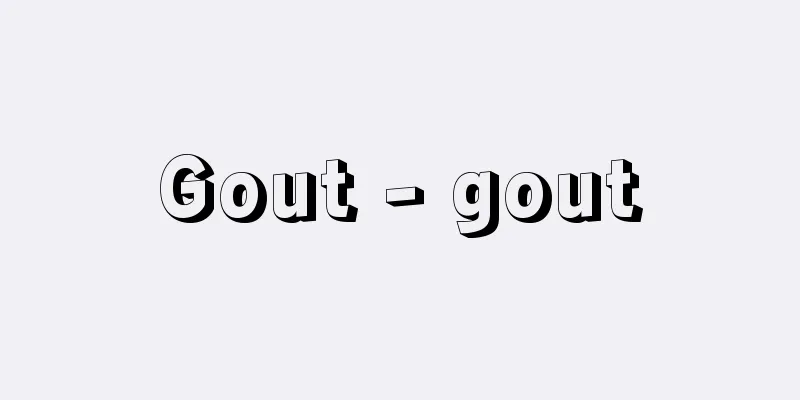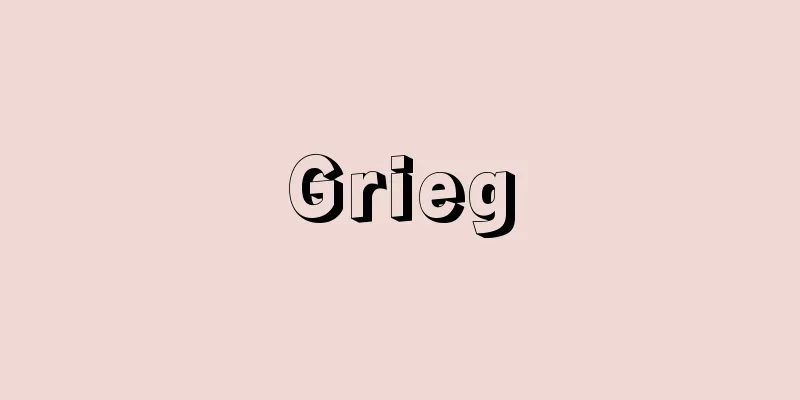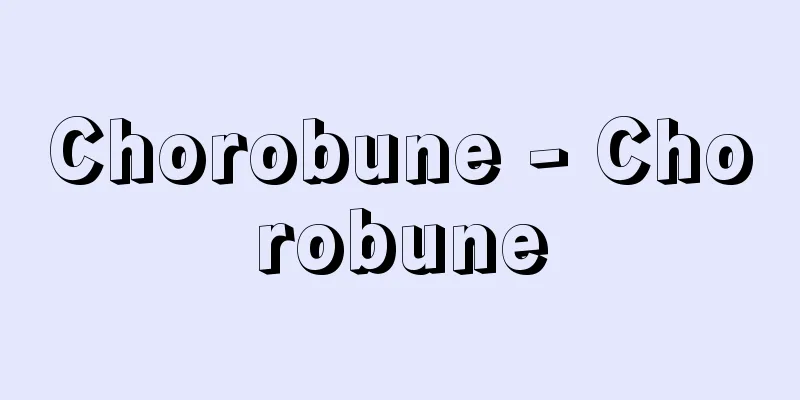Gout - gout

|
It is a general term for a group of diseases that cause acute arthritis due to hyperuricemia, which is a high level of uric acid in the blood. Nucleic acid, a component of cells, is a substance synthesized by combining simple amino acids with purine bases such as adenine and guanine, phosphoric acid, and pentose sugars. This is broken down via purines, and uric acid becomes the final metabolic product of nucleic acid, which is mainly excreted by the kidneys. Therefore, if there is an abnormality in the metabolic process of uric acid, such as increased uric acid production or decreased uric acid excretion, it will cause hyperuricemia and create the foundation for gout. It is easier to understand that nucleic acid is nowadays the substance that makes up genes, such as deoxyribonucleic acid (DNA) and ribonucleic acid (RNA). There are billions of DNAs in one cell, and considering the number of cells that make up the human body (60 trillion), it can be said that a person is made up of about 10 17 DNAs. Gout has been known since the BC era as a disease that makes people unable to walk due to the intense pain in their feet, and it has also been known that saffron is an effective treatment. Later, it was also called a disease of royalty and nobility because many patients enjoy fine food and alcohol. Currently, there are about 600,000 patients visiting the hospital as outpatients in Japan, and the number is increasing. The frequency of hyperuricemia is high among hypertensive patients, and it has become clear that the causes are excessive intake of foods high in purines such as meat, constitutional predisposition, stress, excessive alcohol consumption (especially excessive beer), and obesity. Onset is becoming younger, and it is most common in active adult men in their 30s and 40s, with women accounting for less than 5% of men. In addition, several tens of percent of patients have parents or siblings who suffer from gout other than the patient themselves, making it a familial disease. [Ieyoshi Akaoka] Gouty hyperuricemiaGout or asymptomatic hyperuricemia can be classified into overproduction type, in which uric acid is overproduced, and underexcretion type, in which excretion of uric acid from the kidneys is reduced. Most cases of both types are primary and of unknown cause. Intermediate types are often caused by dietary factors. A special type is Lesch-Nyhan syndrome, in which hyperuricemia is seen in children. This is a male X-linked recessive congenital disease in which a certain enzyme in the purine metabolism is missing, which in turn causes an increase in purine biosynthesis, resulting in a significant overproduction of uric acid. In addition to gout caused by hyperuricemia in childhood, this is a disease that shows intellectual disability, athetosis, in which the patient is unable to maintain the same posture, chorea, which makes the patient appear to be dancing, spasmodic paralysis similar to that seen in strokes, and peculiar self-injury such as biting one's fingers or lips. Diseases that show secondary overproduction of uric acid include polycythemia, which is an increase in red blood cells, leukemia, and glycogen storage disease type I and type VII, which are caused by a deficiency of the enzyme glucose-6-phosphatase. Diseases that show secondary decreased excretion of uric acid include chronic nephritis and acute alcoholism, and there are many cases in which hyperuricemia is shown as a result of impaired uric acid excretion due to drugs such as salicylic acid agents like aspirin and thiazide loop diuretics. [Ieyoshi Akaoka] Gouty arthritisGouty arthritis occurs when uric acid becomes oversaturated in the body and precipitates in joints as needle-like crystals, which are phagocytosed by white blood cells, causing inflammation. After several years, uric acid can be deposited in the joints, as well as in the cartilage of the ears, elbows, soles of the feet, and subcutaneous tissue on the back of the hands without causing inflammation, forming nodular gouty nodules. With acute arthritis, the joint at the base of the big toe suddenly begins to hurt one day, and within a few hours it swells and becomes extremely hot, making it impossible to even stand up. This type of arthritis generally heals completely (goes into remission) within about a week, so it is called an arthritis attack. The big toe is the most common site, with a probability of about 40%, and there is also a probability of about 60% of inflammation occurring in other toes, ankles, Achilles tendons, knee joints, etc. At first, it occurs about once a year, but within a few years the frequency increases and the joint sites spread from small joints to large joints such as the knees and elbows. There are several characteristics of gouty arthritis attacks, as described above. In particular, it is distinct from other arthritis in that (1) it occurs suddenly one day, (2) sometimes the patient is unable to get up in a day, (3) it occurs in one place, (4) once it begins to heal, it occurs in another joint, (5) it is unilateral and asymptomatic, (6) it heals quickly, and (7) taking medicine to lower uric acid usually makes the joint pain worse. In addition, it mainly forms uric acid stones in the kidneys and ureters, and often causes hematuria with red blood cells in the urine and acute pain in the abdomen and back (renal colic). The most important thing in diagnosing it is to check the uric acid level. In the case of hyperuricemia, the level is 7.0 milligrams or more per 100 milliliters of serum, but most gout patients have a level of 9.0 to 10.0 milligrams. If the uric acid level is 8.0 milligrams or more, treatment (medication) is required. [Ieyoshi Akaoka] Complications of goutGout often accompanies metabolic disorders such as obesity, high blood pressure, myocardial damage, diabetes, elevated blood fats, and moderate kidney dysfunction, in addition to obvious kidney damage. This indicates the presence of arteriosclerosis, and if left untreated, it can lead to kidney failure due to reduced kidney function, and early death. However, in recent years, gout treatment has made it possible to prevent complications early on, allowing people to live out their natural lifespans. [Ieyoshi Akaoka] TreatmentIn the past, colchicine, a component of saffron, was used as a specific medicine for acute arthritis attacks (gout attacks). Currently, in addition to colchicine, appropriate doses of nonsteroidal anti-inflammatory drugs and steroids are required. Hyperuricemia causes acute arthritis, urinary tract stones, kidney disorders, etc., and the condition progresses, so the goal of treatment is not only to improve these conditions but also to prevent them. In addition, improving obesity, high blood pressure, and sugar and lipid metabolism are also important in preventing complications. Dietary therapy requires restricting total calorie intake and limiting alcohol intake, which affects the excretion and production of uric acid. When dietary therapy is insufficient, the long-term administration of uric acid excretion promoters (benzbromarone) and uric acid production inhibitors (allopurinol) is required. When urinary stones become a problem, urinary alkalinizers are also important. [Ieyoshi Akaoka] "Gout comes when you least expect it -- Lifestyle techniques to get rid of gout" by Akaoka Ieyu (1993, Goma Shobo)" ▽ "For those concerned about gout" by Akaoka Ieyu (1994, Toyo Publishing)" ▽ "Beware the Gout Frontlines! -- Prevention and Treatment of Hyperuricemia and Gout" by Akaoka Ieyu (1996, Kiba Shokan)" ▽ "How to Live with Gout" by Yamanaka Hisashi (1998, Tokyo Shimbun Publishing Bureau)" ▽ "Easy Self-Management of Gout by Yamanaka Hisashi, Edited by Kamatani Naoyuki (2002, Iyaku Journal Co., Ltd.)" [References] | | | | | | | | | | | arteriosclerosis| | |chorea| |Source: Shogakukan Encyclopedia Nipponica About Encyclopedia Nipponica Information | Legend |
|
血液中の尿酸値が高くなった高尿酸血症から急性の関節炎をおこす疾患群の総称である。細胞成分である核酸は簡単なアミノ酸に、アデニン・グアニンといったプリン塩基、リン酸、五炭糖(ペントース)が結合して合成される物質である。これはプリン体を経て分解され、尿酸が核酸の最終代謝産物となって、おもに腎臓(じんぞう)から排泄(はいせつ)される。したがって、尿酸生成増加、尿酸排泄低下など尿酸の代謝過程に異常がおこると高尿酸血症となり、痛風の素地ができる。なお核酸は、現在ではデオキシリボ核酸(DNA)とリボ核酸(RNA)といった遺伝子をつくる物質といったほうがわかりやすい。一つの細胞の中には数十億個のDNAがあり、人体をつくる細胞数(60兆個)を考えると、人は約1017個のDNAでできているといえる。 痛風は足の激烈な痛みのために歩行できなくなる病気として紀元前から知られ、また治療薬としてサフランが有効であることも知られていた。さらにその後、美食、飲酒の好きな患者が多いところから王侯、貴族の病気ともいわれてきた。現在の日本では約60万人の患者が外来通院し、さらに増加傾向にある。高血圧患者における高尿酸血症患者の頻度が高く、原因は肉類などプリン体の多い食品のとりすぎ、体質素因、ストレス、アルコール飲料過剰摂取(とくにビールの過飲)、肥満などであることが明らかになってきた。発症が若年化し、30歳から40歳代の活動的な成人男性に多く、女性は男性の5%以下である。また、本人以外に親や兄弟などに痛風患者がいる場合も数十%に及び、家族性がある。 [赤岡家雄] 痛風性高尿酸血症痛風ないし無症候性の高尿酸血症には、尿酸が過剰に産生される産生過剰型と、尿酸の腎臓からの排泄が低下している排泄低下型とがあり、いずれも原因不明の一次性のものが大部分を占める。その中間型は食事事情が原因のものが多い。なお、特殊型として小児で高尿酸血症のみられるレッシュ・ナイハンLesch-Nyhan症候群がある。これは、プリン代謝系の一種の酵素が欠損しているため、逆にプリン生合成の亢進(こうしん)からさらに尿酸の著しい過剰産生がおこる男性の伴性劣性の先天性疾患である。幼少時に高尿酸血症から痛風になるほか、知能障害をはじめ、同じ姿勢が維持できないアテトーゼ(アテトーシス)、踊っているようにみえる舞踏病、脳卒中にみられるようなけいれん性麻痺(まひ)、自分の指や口唇をかじる特異な自傷行為などを示すひとつの疾患である。 二次性に尿酸の過剰産生を示す疾患としては赤血球の増加する多血症のほか、白血病をはじめ、グルコース-6-フォスファターゼという酵素が欠損しておこるⅠ型糖原病、Ⅶ型糖原病などがある。二次性に尿酸の排泄が低下する疾患としては慢性腎炎や急性アルコール中毒があり、薬剤ではアスピリンのようなサリチル酸剤やサイアザイド系のループ利尿剤などによる尿酸排泄障害の結果高尿酸血症が示される例も少なくない。 [赤岡家雄] 痛風性関節炎痛風の関節炎は、体内で過飽和になった尿酸が針状の結晶として関節内などに析出し、それを白血球が貪食(どんしょく)して炎症がおきた状態である。数年経過すると尿酸は関節内のほか、耳の軟骨部、肘(ひじ)や足底、手背の皮下などにも炎症をおこさずに沈着し、結節状の痛風結節をつくることがある。 急性の関節炎は、ある日突然に足の母指(親指)の基部の関節が痛み始め、数時間内に腫(は)れて熱感が強度になり、起立さえできなくなる。この関節炎は一般に1週間くらいで完全に治る(寛解)ので関節炎発作とよばれる。足の母指が好発部位であるが、その確率は40%くらいで、足の他の指、足首、アキレス腱(けん)部、膝(しつ)関節などに炎症がおこることも60%くらいの確率である。初めは年に1回くらいであるが、数年内に頻度が増加するとともに、関節部位も小関節から膝、肘(ちゅう)関節など大関節へと広がる。痛風性関節炎発作には、このようにいくつかの特徴がある。とくに、(1)ある日突然おきる、(2)ときには1日で起床できなくなる、(3)1か所におきる、(4)治りかけると別の関節にもおきる、(5)片側性で非対性である、(6)治るのは早い、(7)尿酸を下げる薬を服用すると、さらに関節痛が悪化することも普通である、などは、ほかの関節炎と明らかに違うところである。そのほか、腎臓や尿管などに主として尿酸の結石をつくり、尿中に赤血球の出る血尿、腹背部の急性の痛み(腎仙痛)などがしばしばおこる。診断には尿酸値の検査が最重要で、高尿酸血症の場合は血清100ミリリットル中に7.0ミリグラム以上とされているが、痛風患者の多くは9.0~10.0ミリグラムである。なお、尿酸値が8.0ミリグラム以上の場合は治療(服薬)が必要とされている。 [赤岡家雄] 痛風の合併症痛風は明らかな腎障害のほか、代謝障害として、肥満、高血圧、心筋障害、糖尿病、血中脂肪の増加や中等度の腎臓の機能障害などを合併することが多い。これは動脈硬化があることを示すもので、放置すると腎機能低下から腎不全をおこし、早期に死亡する可能性がでてくる。しかし、最近は痛風の治療によって合併症が早期に予防され、天寿を全うできるようになってきた。 [赤岡家雄] 治療急性関節炎発作(痛風発作)に対して、昔はサフランの成分であるコルヒチンが特効薬として用いられてきた。現在はコルヒチンのほか、非ステロイド抗炎症剤、ステロイド剤の適切な量の投与が必要とされている。高尿酸血症が急性関節炎、尿路結石、腎臓障害などの原因となり、病状が進展していくので、この改善のほか予防が治療の目標となる。また、肥満、高血圧、糖や脂質の代謝改善も合併症の防止のうえで、たいせつである。 食事療法としては食品の摂取総カロリー量制限、尿酸の排泄、産生に影響を与えるアルコール類の摂取抑制が必要になる。食事療法で不十分なときは、尿酸排泄促進剤(ベンズブロマロン)や尿酸産生抑制剤(アロプリノール)などの長期間の投与が必要となる。尿路結石が問題になるときは、尿アルカリ化剤もたいせつとなる。 [赤岡家雄] 『赤岡家雄著『痛風は忘れたころにやってくる――痛風を退治する生活術』(1993・ごま書房)』▽『赤岡家雄著『痛風が気になる人へ』(1994・東洋出版)』▽『赤岡家雄著『「痛風」前線にご用心!――高尿酸血症・痛風の予防と治療』(1996・木馬書館)』▽『山中寿著『痛風とつきあう法』(1998・東京新聞出版局)』▽『鎌谷直之監修・山中寿著『やさしい痛風の自己管理』(2002・医薬ジャーナル社)』 [参照項目] | | | | | | | | | | | | | | | | | |出典 小学館 日本大百科全書(ニッポニカ)日本大百科全書(ニッポニカ)について 情報 | 凡例 |
<<: Common division - Common division
>>: Tong-pan (English spelling)
Recommend
Reactive Polymers - Reactive Polymers
When used as materials, polymers are generally exp...
Lake Kamafusa
The reservoir of the Kamafusa Dam on the Goishi Ri...
Krylov, Ivan Andreevich
Born: February 13, 1769, Moscow Died November 21, ...
Published by Idashi Akome
〘 noun 〙 A type of outer garment. The hem of the o...
inverted echo sounder
...A sonic wave gauge is installed on the ocean f...
Light absorption
Light absorption is the phenomenon in which the en...
Kannabe [town] - Kannabe
An old town in Fukayasu County, located in the sou...
Wang Yan-de (English spelling)
[Raw] Tenpuku 4 (939) [Died] 1006 The first milita...
Orbital platform - Kidou platform (English spelling) space platform
A large, multi-purpose satellite in orbit around t...
First Torii Gate - Ichinotorii
① The first torii gate counting from the entrance ...
Sambucus canadensis (English spelling) Sambucuscanadensis
…[Hiroshi Aramata]. … *Some of the terminology th...
Antonin Artaud
French poet, actor, and director. Born on Septemb...
Corvidae
...Also closely related to the crow genus are the...
Shinobuzaka
The ancient name of the area on the western foot o...
Local Transportation Lines
According to the Law for Special Measures for Prom...









